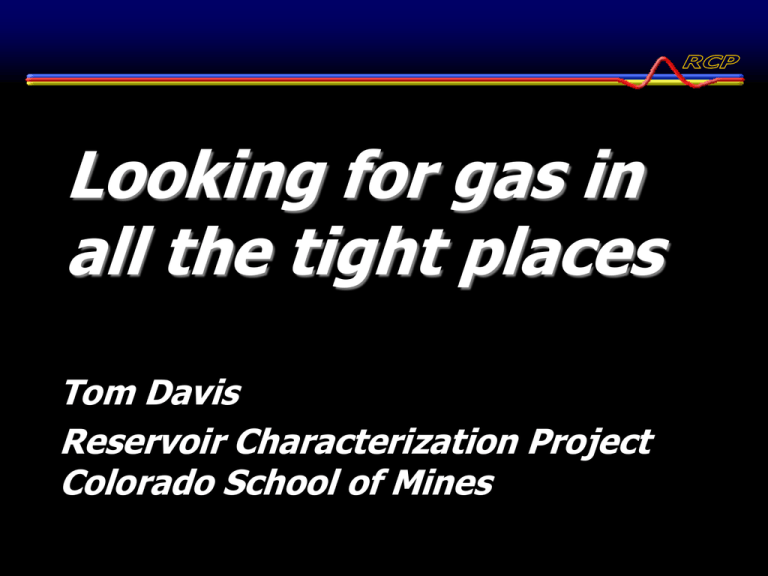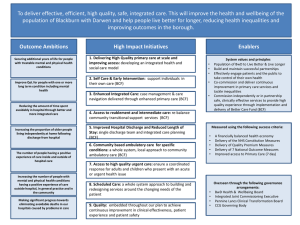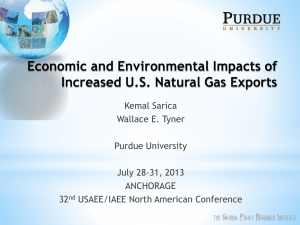Reservoir Characterization Project
advertisement

Looking for gas in all the tight places Tom Davis Reservoir Characterization Project Colorado School of Mines Rulison Field Location of Rulison Field Rangley Meeker Mesaverde Outcrop Grand Valley Rulison Parachute Grand Junction Modified from Johnson (1989) Rifle Glenwood Springs Mamm Creek Mesaverde Tight Gas Sands Piceance Basin Center Gas Williams Fork Formation Schematic: Basin Centered, Lenticular Gas Sand Accumulation DeBeque Wasatch Gas Transition Zone (Currently not Completed) Grand Valley Parachute Rulison Transition Zone Gas Saturated WILLIAMS FORK FORMATION West East (Courtesy Williams) CAMEO MEMBER Gas Bearing Sequence (1700’ - 2400’) 4-5 Fracs 20-30 Sands Rulison Reservoir Properties Av. drilling depth to top of Rollins 8500 ft Av. thickness of gas saturated section 1700-2400ft Pore pressure gradient 0.44-0.66 psi/ft Log porosity 6-14 % Frac gradient 0.6-0.9 psi/ft Matrix permeability 0.1-2.0 microd Effective permeability 10-50 microd Reserves 135 BCF Average EUR/well 1.65 BCF Well spacing 10 acres EUR vs. Net Pay Poor Correlation of Net Pay to EUR Courtesy of: Fracture Significance Production Decline Curve with Fracture Signature 105 •Fractures in a well tend to produce first. •Followed by reservoir matrix production. Slope 1 MCF Slope 2 104 Reservoir Matrix Dominated Production Fracture Dominated Production Jackson, 2007 103 1 2 3 Years 4 5 6 Natural fracture detection technology can impact development of tight gas reservoirs more than any other single technology Ostby, 2003 Economics • Dual Perm, 2.1 Bcf/Well, $1.10/Mcf profit at 5$/Mcf • Single Perm, 1.4 Bcf/Well, $ .05/Mcf profit at 5$/Mcf Vello Kuuskraa, ARI, 2006 Drilling Program 3D Survey Outline Drilling Program 2005 – ‘06 Wells 2006 – ‘07 Wells Estimated Ultimate Recovery 0.00-0.50 0.50-1.00 1.00-1.50 1.50-2.00 2.00-2.50 > 2.50 EUR in BCF/well Courtesy Williams Production Co Seismic Acquisition Grid Source Location Receiver Location R94W VSP Location T 6 S 1 Mile Seismic Acquisition Parameters Type survey Subsurface bin size Number of receiver pts Number of source pts Receiver grid 4-D, 9-C (time-lapse) 55’ X 55’ 1500 770 110’ inline, 330’ line space Source grid Instrumentation Receiver array Source array (P-wave) 110’ inline, 660’ line space I/O VectorSeis® System IV 1, 3-C VectorSeis® SVSM Vertical vibrator Source array (S-wave) Shear wave vibrator -Two orthogonal horizontal orientations Seismic volumes in PP time PP volume S11 volume PS1 volume MSVRD UMV Cameo Coal_D Guliyev, 2006 Difference (03-96) MVRD UMV Shale Cameo Davis et al, 2003 ‘03 – ‘06 P-P Difference Xequal gate 225ms 16 RMS Ampl. of Diff. ’03-’06 11 Gas Migration- Rulison Reservoir Fracture zone Cameo Coal overpressure Davis, 2004 Fast vs. Slow Shear Waves • Fast – S1 – rotated to be parallel to faults & fractures • Slow – S2 – rotated to be perpendicular to faults & fractures (Martin & Davis, 1987) Resistive fractures for 3 study wells Matesic, 2007 Time-variant Time Shifting Original Data S1 Shifted Data S2 S1: Original S2: Shifted Transform Software’s TerraMorphTM Volume Registration and Warper Impedance Anisotropy A A Anisotropy Log Well Intersection UMV B Cameo LaBarre 2007 B Converted Wave Splitting Araman 2009 Subsurface Feature Identification S Two-way Time (ms) N 25 RMS Amplitude Map at Reservoir Interval (Depth: 6000-6200 ft) 500 ft Mazumdar 2009 Where to drill next? Upper Mid-Reservoir EUR in BCF/well 1.00-1.50 1.50-2.00 2.00-2.50 > 2.50 From LaBarre, 2007 Integrated Interpretation: Time-lapse results Slow VP/VS relative (%) difference 2003-2006 @6200 ft 15% 0% Meza, 2008 -15% EUR and Faults Well EUR (BCF): 0.00-0.50 Well EUR (BCF): 0.50-1.00 Well EUR (BCF): 1.00-1.50 Well EUR (BCF): 1.50-2.00 Well EUR (BCF): 2.00-2.50 Well EUR (BCF): 2.50-10.00 Faults From LaBarre, 2006; EUR from Williams, 2003 Diagenetic Influences on Seismic Attributes Vp/Vs and Clay Content 1.9 1.85 1.8 Vp/Vs 1.75 1.7 1.65 1.6 1.55 1.5 0 0.5 1 1.5 2 2.5 3 3.5 Increasing Clay Volume Clay content 4 Stroker 2008 4.5 5 Vp/Vs1 Volume Section Vp/Vs 2.23 1.58 Guliyev, 20066) /Vs log overlay VP/VS Ratio – Bottom UMV Shale VP/VS Ratio - 2.0 - 1.9 - 1.8 - 1.7 - 1.6 - 1.5 From Araman 2009 - 1.4 Expected Ultimate Recovery Economics Drill the best wells first: 5$/mcf x 1 bcf incremental EUR = 5 million dollars/well Reduce fracing cost fracing into depleted zones: 200,000$/frac stage, saving 2 frac stages/well = 400,000$/well 30% incremental recovery: (recompletions) =.6 bcf x 5$/ MCF = 3 million dollars/well Conclusions • The best fairway for production at Rulison Field is associated with tectonic fracturing • Fractured sandstone geobodies can be detected with shear wave seismic data Conclusions • Time – lapse shear wave seismic data can detect pressure depleted zones • Dynamic reservoir characterization can increase recovery in tight gas reservoirs Take Away Message IT PAYS TO LOOK IN TIGHT PLACES! With the right tools. Acknowledgements Adnoc, Anadarko, BG –Group, BP, CGGVeritas, Chaparral, Chesapeake, Sinopec, ConocoPhillips, Dawson, Denbury, Devon, ENI, ExxonMobil, Fairfield, Fugro, Fusion, Geokinetics, Hi-Point, IHS, ION, iReservoir, Kuwait Oil Company, Landmark, Noble, OXY, OYO Geospace, Paradigm, Paragon, Petrobras, Polish Res. Inst., RepsolYPF, Reservoir Imaging, RWE, Schlumberger, SMT, Shell, Talisman, Total, Triangle, Transform, Tundra, Whiting, Williams & Vecta Oil and Gas




